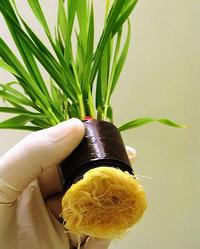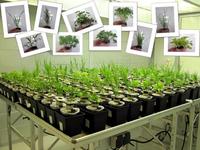From research tool to assessment tool
The RHIZOtest has technical and methodological characteristics that enable its routine use on a large scale.
The RHIZOtest, such as it has been developed for basic research purposes, has some technical and methodological characteristics that enable its routine large-scale use as a biological method (i.e. biotest) for assessing the phytoavailability of trace elements [1].
-
The size of the RHIZOtest device has been reduced to enable more treatments (e.g. types of soil, plant species, etc.) per unit area of growth chamber (100-150 devices m–2).
- While the root compartment often plays a paramount role in determining the phytoavailability of trace elements, use of the root mat technique involving the physical
separation of roots and soil makes it easy to recover a clean root system (i.e. not contaminated by soil particles).
- The RHIZOtest has already been used to estimate the phytoavailability of many trace elements in a specific manner, such as As, Cd, Co, Cr, Cs, Cu, Ni, Pb and Zn.
- The RHIZOtest is adapted to many plant species. Seventeen plant species have already been grown with the RHIZOtest: Brassica napus, Brassica oleracea, Bromus mollis, Festuca arundinacea, Festuca ovina, Festuca rubra, Hordeum vulgare, Lactuca sativa capitata, Lolium perene, Lycopersicon esculentum, Medicago sativa, Nicotiana tabacum, Raphanus sativus, Sorghum bicolour, Trifolium pratense, Triticum aestivum, Triticum turgidum durum.
- Lastly, the growth period is relatively short (3 weeks: 2 weeks’ growth and 1 week’s exposure to soil) for a biological method based on plant cultivation.
1. De Vaufleury A et Bravin M 2011 Outils d’évaluation de la biodisponibilité des contaminants dans les sols et apport en éRé. Synthèse de l’atelier n°2 - Séminaire ADEME sur l’évaluation des Risques pour les écosystèmes, 20 p.



